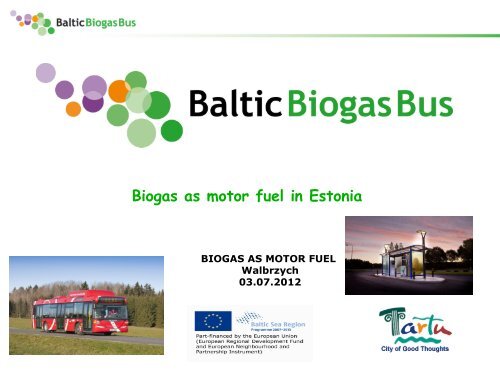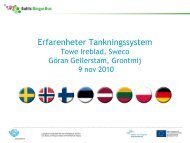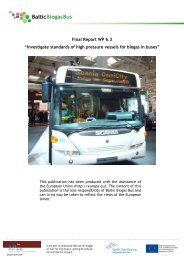Biogas as motor fuel in Estonia - Baltic Biogas Bus project
Biogas as motor fuel in Estonia - Baltic Biogas Bus project
Biogas as motor fuel in Estonia - Baltic Biogas Bus project
You also want an ePaper? Increase the reach of your titles
YUMPU automatically turns print PDFs into web optimized ePapers that Google loves.
<strong>Biog<strong>as</strong></strong> <strong>as</strong> <strong>motor</strong> <strong>fuel</strong> <strong>in</strong> <strong>Estonia</strong><br />
BIOGAS AS MOTOR FUEL<br />
Walbrzych<br />
03.07.2012
<strong>Estonia</strong><br />
Population: 1 300 000<br />
Area: ca 45 000 km2
Bio<strong>fuel</strong>s<br />
Situation <strong>in</strong> <strong>Estonia</strong><br />
Mandatory targets set by the EU Directive<br />
on the Promotion of the use of energy from<br />
renewable sources:<br />
At le<strong>as</strong>t 10% share of renewable energy <strong>in</strong><br />
f<strong>in</strong>al consumption of energy <strong>in</strong> transport by<br />
2020.<br />
Excise tax exemption for biog<strong>as</strong> only.<br />
<strong>Estonia</strong>’s National Renewable Energy Action<br />
Plan set’s a 2020 target : at le<strong>as</strong>t 10<br />
percent share of bio-<strong>fuel</strong>s of f<strong>in</strong>al energy<br />
consumption <strong>in</strong> transport sector.<br />
The share of bio<strong>fuel</strong>s <strong>in</strong> transport <strong>in</strong><br />
<strong>Estonia</strong> is amounted to 1.76%.
Biomethane <strong>in</strong> <strong>Estonia</strong><br />
Situation <strong>in</strong> 2012 - no biomethane <strong>in</strong> the market<br />
The current CNG price (0.779 €/kg) doesn’t support it yet, but<br />
the Government of <strong>Estonia</strong> is consider<strong>in</strong>g to adopt some<br />
support mechanisms to promote biomethane used <strong>in</strong> transport.<br />
The 60% of annual biomethane applicable potential forms 25%<br />
of annual diesel consumption or 39% annual petrol consumption.<br />
The number of NGVs h<strong>as</strong> <strong>in</strong>cre<strong>as</strong>ed from 4 <strong>in</strong> 2009 to 200 <strong>in</strong><br />
2012<br />
The number of public re<strong>fuel</strong>l<strong>in</strong>g station <strong>in</strong>cre<strong>as</strong>ed from zero<br />
(2009) to 2 (2011).
Usage of methane <strong>fuel</strong>s <strong>in</strong><br />
<strong>Estonia</strong> (m3/year)<br />
Tartu<br />
Tall<strong>in</strong>n<br />
<strong>Estonia</strong>
<strong>Biog<strong>as</strong></strong> plants <strong>in</strong> <strong>Estonia</strong>
Production of biog<strong>as</strong> <strong>in</strong><br />
<strong>Estonia</strong><br />
Landfills<br />
Manure<br />
Sewage sludge
G<strong>as</strong> fill<strong>in</strong>g stations <strong>in</strong><br />
<strong>Estonia</strong>
Today:<br />
5 buses <strong>in</strong> Tartu City<br />
2 buses <strong>in</strong> Tall<strong>in</strong>n Airport<br />
In the near future (end of 2012):<br />
7 buses <strong>in</strong> Pärnu City<br />
6 buses <strong>in</strong> Narva City<br />
G<strong>as</strong> buses <strong>in</strong> <strong>Estonia</strong>
<strong>Estonia</strong>n biog<strong>as</strong> potential<br />
<strong>Estonia</strong> adopted National Renewable Energy Action Plan <strong>in</strong> 2010, which states that the<br />
share of renewable energy h<strong>as</strong> to <strong>in</strong>cre<strong>as</strong>e to 10% of the gross f<strong>in</strong>al consumption of<br />
energy <strong>in</strong> transport sector by 2020 <strong>in</strong> <strong>Estonia</strong>. The share of bio<strong>fuel</strong>s used <strong>in</strong> transport<br />
h<strong>as</strong> to <strong>in</strong>cre<strong>as</strong>e 92 times, from 1 ktoe to 92 ktoe.<br />
The total annual theoretical biog<strong>as</strong> production is 1322 million Nm³ and total annually<br />
applicable biog<strong>as</strong> is 502 million Nm³.<br />
The annual biomethane (98% CH4) production from applicable biog<strong>as</strong> amount is 301<br />
million Nm³, which is more than one third of <strong>Estonia</strong>n annual natural g<strong>as</strong><br />
consumption, 702 million Nm³. There could be 100-200 biog<strong>as</strong> plants <strong>in</strong> <strong>Estonia</strong>.
Potential of biog<strong>as</strong> and<br />
biomethane <strong>in</strong> <strong>Estonia</strong>
<strong>Biog<strong>as</strong></strong> strategy and action<br />
plan<br />
By M<strong>in</strong>istry of Communication and Economic<br />
Affairs w<strong>as</strong> <strong>in</strong>itiated <strong>in</strong> the spr<strong>in</strong>g of 2011 a<br />
work<strong>in</strong>g group t<strong>as</strong>ked with develop<strong>in</strong>g<br />
proposals for the <strong>in</strong>troduction of biog<strong>as</strong> <strong>in</strong> the<br />
transport system <strong>in</strong> <strong>Estonia</strong>.<br />
Work<strong>in</strong>g group comprised a representative of<br />
the <strong>Baltic</strong> <strong>Biog<strong>as</strong></strong> <strong>Bus</strong> <strong>project</strong>.<br />
The work<strong>in</strong>g group's proposals were<br />
overhanded to representatives of the<br />
M<strong>in</strong>istry of Communication and Economic<br />
Affairs on 04.06.2012.<br />
The proposals aim is to achieve a situation by<br />
2020 <strong>in</strong> form<strong>in</strong>g bio<strong>fuel</strong>s (biog<strong>as</strong>) at le<strong>as</strong>t 10%<br />
of <strong>fuel</strong> used <strong>in</strong> <strong>Estonia</strong>'s transport system.
Solutions. Decisions <strong>in</strong> National level.<br />
<strong>Biog<strong>as</strong></strong> <strong>as</strong> <strong>motor</strong> <strong>fuel</strong><br />
Green electricity & electric cars<br />
Blend<strong>in</strong>g of petrol and diesel (10%)
Situation <strong>in</strong> public transport<br />
Number of bus l<strong>in</strong>es: 25<br />
<strong>Bus</strong>es <strong>in</strong> daily use: 50<br />
(5 CNG and 45 diesel buses)<br />
Responsible organisation:<br />
Department of Communal<br />
Services of Tartu City<br />
Government<br />
No biog<strong>as</strong> <strong>in</strong> the market today<br />
Estimated consumption of<br />
biomethane <strong>in</strong> the future:<br />
2 300 000 m3/year
Targets set by Tartu City transport development<br />
plan 2012-2020. Long term policy.<br />
Incre<strong>as</strong><strong>in</strong>g the role of public<br />
transport<br />
Incre<strong>as</strong><strong>in</strong>g the number of buses<br />
runn<strong>in</strong>g on the g<strong>as</strong>. At le<strong>as</strong>t 50%<br />
(hopefully 100%) of bus fleet will<br />
be g<strong>as</strong>buses from 2017-2018<br />
Introduction of biog<strong>as</strong> <strong>in</strong> the<br />
city buses
Situation <strong>in</strong> biog<strong>as</strong> production and<br />
-<strong>in</strong>fr<strong>as</strong>tructure <strong>in</strong> Tartu<br />
Under construction is a biog<strong>as</strong><br />
plant <strong>in</strong> Tartu water company<br />
(estimated production : 140<br />
m3/h)<br />
Established pipes for g<strong>as</strong> <strong>in</strong><br />
Aardlapalu landfill (estimated<br />
production: 500 m3/h)<br />
1 fill<strong>in</strong>g station (CNG)<br />
No bus depot for biog<strong>as</strong> buses<br />
Established good contacts with<br />
g<strong>as</strong> companies - Eesti Ga<strong>as</strong>,<br />
G<strong>as</strong>um, Ga<strong>as</strong>ienergia
<strong>Biog<strong>as</strong></strong> from city area<br />
The city of Tartu is look<strong>in</strong>g at ways to use Aardlapalu landfill g<strong>as</strong><br />
for city buses<br />
If all (50) buses <strong>in</strong> Tartu public transport would use biomethane<br />
the needed amount would be about 2 300 000 m3/year.<br />
From municipal and <strong>in</strong>dustrial biow<strong>as</strong>tes (<strong>in</strong>clud<strong>in</strong>g sewage sludge)<br />
collected from city area we will get about 1 500 000 m3 of biog<strong>as</strong><br />
per year = about 800 000 m3 biomethane/year.<br />
<strong>Biog<strong>as</strong></strong> from landfill - about 1 800 000 m3 biomethane/year.<br />
Tartu city is able to cover from resources available <strong>in</strong> the city<br />
territory 100% of biomethane necessary to <strong>fuel</strong> city buses.
Conclusions<br />
It is convenient to take <strong>in</strong> use natural g<strong>as</strong><br />
and natural g<strong>as</strong> <strong>in</strong>fr<strong>as</strong>tructure and later<br />
switch to biog<strong>as</strong>.<br />
State and local governments should be<br />
<strong>in</strong>itiators and pioneers.<br />
It is important to use all resources we<br />
have , espcially w<strong>as</strong>tes. There are a great<br />
positive socio-economical and<br />
environmental impacts.<br />
To do outreach work <strong>in</strong> national level<br />
(Government, Parliament) to ensure a<br />
support and lower taxation on biog<strong>as</strong> and<br />
natural g<strong>as</strong>.
Thank you!<br />
<strong>Baltic</strong> <strong>Biog<strong>as</strong></strong> <strong>Bus</strong> Project<br />
2009–2012<br />
Jaanus Tamm<br />
<strong>project</strong> manager<br />
Tartu City Government







